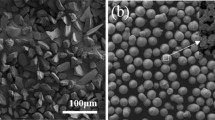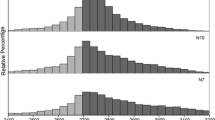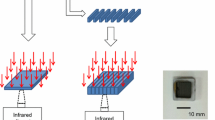Abstract
In thermal barrier coatings (TBCs), the thermal radiative transfer becomes important in the overall heat transfer with higher turbine inlet temperature. The microstructure, including pore size distribution and pore morphology, primarily impacts TBCs’ radiative properties. Modifying the microstructure is an effective method to change the radiative and overall heat transfer in TBCs. In this study, a new approach is developed to modify the microstructure of atmospheric plasma sprayed (APS) topcoats by mixing the fugitive polyester powder of various sizes into the base 8 wt.% yttria-stabilized zirconia (8YSZ) powder. By changing the polyester powder size and the volumetric mixing ratio, several 8YSZ films are fabricated, and their scattering coefficients are inverted from the directional-hemispherical transmittance and reflectance measurement in the infrared wavelength range. A detailed discussion of the microstructure changes due to the powder mixture and the resulting scattering coefficient changes is presented. The results show that mixing polyester with the 8YSZ powder is a very effective way to modify the microstructure of the topcoat and increase the scattering coefficient. A preferred microstructure that can result in a higher scattering coefficient will contain a higher fraction of interlamellar pores and large-size pores in the APS topcoat.














Similar content being viewed by others
Change history
27 December 2023
A Correction to this paper has been published: https://doi.org/10.1007/s11666-023-01702-2
References
L. Wang, J.I. Eldridge, and S.M. Guo, Thermal Radiation Properties of Plasma-Sprayed Gd2Zr2O7 Thermal Barrier Coatings, Scripta Mater., 2013, 69(9), p 674–677.
Y. Wang and P.-F. Hsu, The Correlation of the Scattering Coefficient and Morphology-Based Microstructure in Yttria-Stabilized Zirconia Coatings, J. Am. Ceram. Soc., 2023, 106(3), p 2083–2094. https://doi.org/10.1111/jace.18899
M.F. Modest and S. Mazumder, Radiative Heat Transfer, 4th ed. Academic Press, Oxford, UK, 2021.
Q. Flamant and D.R. Clarke, Opportunities for Minimizing Radiative Heat Transfer in Future Thermal and Environmental Barrier Coatings, Scripta Mater., 2019, 173, p 26–31.
D.E. Wolfe, J. Singh, R.A. Miller, J.I. Eldridge, and D.M. Zhu, Tailored Microstructure of EB-PVD 8YSZ Thermal Barrier Coatings with Low Thermal Conductivity and High Thermal Reflectivity for Turbine Applications, Surf. Coat. Technol., 2005, 190(1), p 132–149.
T.L. Bergman, F.P. Incropera, D.P. Dewitt, and A.S. Lavine, Fundamentals of Heat and Mass Transfer, Wiley, New York, NY, 2011.
M.J. Kelly, D.E. Wolfe, J. Singh, J. Eldridge, D.M. Zhu, and R. Miller, Thermal Barrier Coatings Design with Increased Reflectivity and Lower Thermal Conductivity for High-Temperature Turbine Applications, Int. J. Appl. Ceram. Technol., 2006, 3(2), p 81–93.
A. Stuke, H. Kassner, J.L. Marqués, R. Vassen, D. Stöver, and R. Carius, Suspension and Air Plasma-Sprayed Ceramic Thermal Barrier Coatings with High Infrared Reflectance, Int. J. Appl. Ceram. Technol., 2012, 9(3), p 561–574.
C.U. Hardwicke and Y.-C. Lau, Advances in Thermal Spray Coatings for Gas Turbines and Energy Generation: A Review, J. Therm. Spray Technol., 2013, 22(5), p 564–576.
P. Pathak, D. Dzhurinskiy, A. Elkin, P. Shornikov, S. Dautov, and V. Ivanov, Enhanced High-Temperature YSZ-Polyester Abradable Honeycomb Seal Structures, J. Therm. Spray Technol., 2022, 31(1–2), p 307–314.
ASTM E2109-01, Standard Test Methods for Determining Area Percentage Porosity in Thermal Barrier Coatings, ASTM International, West Conshohocken, PA, 2014
Y. Wang, P.-F. Hsu, and Y. Wu, Thermal Radiative Properties of Zirconium Oxide Films in the Near-Infrared Wavelengths, Int. J. Appl. Ceram. Technol., 2022, 19(4), p 2311–2321. https://doi.org/10.1111/ijac.14047
J.I. Eldridge and C.M. Charles, Determination of Scattering and Absorption Coefficients for Plasma-Sprayed Yttria-Stabilized Zirconia Thermal Barrier Coatings, J. Am. Ceram. Soc., 2008, 91(5), p 1603–1611.
Z. M. Zhang, B. K. Tsai, and G. Machin, Radiometric Temperature Measurements I: Fundamentals, Vol. 42 in Experimental Methods in the Physical Sciences, Academic Press, 2010
J. I. Eldridge, C. M. Spuckler, K. W. Street, and J. R, Markham, Infrared Radiative Properties of Yttria–Stabilized Zirconia Thermal Barrier Coatings, in The 26th Annual Conference on Composites, Advanced Ceramics, Materials, and Structures: B: Ceramic Engineering and Science Proceedings, eds. H.-T. Lin and M. Singh. https://doi.org/10.1002/9780470294758.ch47, 2002
C.F. Bohren and D.R. Huffman, Absorption and Scattering of Light by Small Particles, Wiley, New York, NY, 1983.
J.R. Howell, M.P. Menguc, and R. Siegel, Thermal Radiation Heat Transfer, 6th ed. CRC Press, Taylor & Francis Group, Boca Raton, FL, 2016.
X. Lu and P.-F. Hsu, Parallel Computing of an Integral Formulation of Transient Radiation Transport, J. Thermophys. Heat Transf., 2003, 17(4), p 425–433.
Acknowledgment
The authors are indebted to Ms. Shari Fowler-Hutchinson of Saint-Gobain for providing the standard and customized polyester powder samples.
Author information
Authors and Affiliations
Corresponding author
Additional information
Publisher's Note
Springer Nature remains neutral with regard to jurisdictional claims in published maps and institutional affiliations.
The original online version of this article was revised: In the original article, Figures 4, 5, 6, and 7 were published incorrectly.
The figures should appear as follows:
Figure 4: Room temperature spectral directional-hemispherical (a) transmittance and (b) reflectance of 8YSZ films of MX-1
Figure 5: Room temperature spectral directional-hemispherical (a) transmittance and (b) reflectance of 8YSZ films of MX-2
Figure 6: Room temperature spectral directional-hemispherical (a) transmittance and (b) reflectance of 8YSZ films of MX-3
Figure 7: Room temperature spectral directional-hemispherical (a) transmittance and (b) reflectance of 8YSZ films of MX-4
Appendix: reduction of the absorption and scattering coefficients
Appendix: reduction of the absorption and scattering coefficients
There have been significant developments in the solution methods of the radiative transfer equation (RTE) over the last three decades. An overview can be found in Howell et al. (Ref 17). In this study, the RTE was solved by a hybrid approach which combines Kubelka-Munk (KM) four-flux method and discrete ordinate method (DOM) accurately and efficiently during the inversion of radiative properties. The details of KM method are given in (Ref 13). A brief description of the DOM is given below. More details are given in (Ref 3).
The RTE is an integrodifferential equation to describe the propagation of the radiative intensity, I, inside the participating media. This equation can be written as,
Where r is the position inside the medium, κ is the absorption coefficient, σs is the scattering coefficient, β = κ + σs is the extinction coefficient, Φ is the scattering phase function, which describes the probability that a ray from an incoming direction, ŝ′, will be scattered into the intensity propagation direction, ŝ, and Ω′ is the solid angle of all incoming directions, ŝ′. The derivation and physical interpretation of each term in Eq. (1) can be found in Ref 3. The optical thickness of a given coating is the product of β and coating thickness. In the DOM, the intensity I is solved for a set of n different directions ŝi, i = 1,…, n, and the integral over the solid angle is replaced by the numerical quadrature,
where wi are the quadrature weights associated with the directions ŝi. Detailed discussion of the DOM numerical scheme can be found in Ref 3. The convergence criterion for terminating the DOM iteration is given below,
where m is the total number of one-dimensional volume elements, i index is the i-th angular direction, j index is the j-th volume element number, and k is the iteration count.
After the solution is converged, the transmittance and reflectance of the collimated incident beam can be obtained as,
where Ic is the incident collimated intensity, and wc and µc is the associated quadrature weight and direction cosine. Ic0 is the transmitted intensity in collimated direction, while ITi and IRi are the transmitted and reflected intensity in various angular direction i. ρ is the reflectivity of the exterior surface, which is defined by Fresnel’s Law (Ref 3).
In general, besides the volume element size, the accuracy of the DOM depends on the number of the intensity used in the angular quadrature Eq. (2). To improve the solution accuracy or just to avoid erroneous results, the asymmetric spherical ring (ASR) angular quadrature (Ref 18) was used in this study. The main idea of this method is to separate the unit sphere into a number of rings and make the associated solid angle for each angular direction approximately equal. By using ASR, any arbitrarily large number of angular directions can be generated.
In solving RTE, the DOM provides accurate solutions at any optical thickness. While solving the transmittance and reflectance of optically thick media, both DOM and four-flux method are equally accurate, but the latter is far more computationally efficient. On the other hand, the four-flux method is not accurate when the optical thickness is a small value, or the medium is optically thin. A least square fitting procedure was used to determine the scattering and absorption coefficients at a given wavelength where the transmittance and reflectance computed by a hybrid approach, in which the DOM or the KM method was used depending on the optical thickness, were compared with the measured transmittance and reflectance. The fitting process started with an initial guess of the scattering and absorption coefficients. At the end of each iteration, the sum of residual squares (Eq. 6) is calculated by using the differences of measured and calculated transmittance and reflectance, respectively. Following the same criterion used by Eldridge and Spuckler (Ref 13), the residual squared summed over all YSZ films in the same batch, Z, is given by,
In the successive iteration, the newly selected scattering and absorption coefficient are used to compute the film overall optical thickness, τ. If τ is greater than 10, then KM method is used in computing the transmittance and reflectance. Otherwise, the DOM is used. In the main program, there is a decision step based on the τ value to determine either the DOM or the KM method is to be used to solve the RTE at any given wavelength. The scattering and absorption coefficients were searched by an algorithm called Trust-Region-Reflective Least Squares Algorithm, which is a built-in function in MATLAB, and were determined as soon as Z reaches a minimum of 10-3.
Rights and permissions
Springer Nature or its licensor (e.g. a society or other partner) holds exclusive rights to this article under a publishing agreement with the author(s) or other rightsholder(s); author self-archiving of the accepted manuscript version of this article is solely governed by the terms of such publishing agreement and applicable law.
About this article
Cite this article
Wang, Y., Hsu, Pf. Microstructure Modifications to Enhance the Scattering Coefficient of Porous Yttria-Stabilized Zirconia Coatings. J Therm Spray Tech 33, 181–194 (2024). https://doi.org/10.1007/s11666-023-01689-w
Received:
Revised:
Accepted:
Published:
Issue Date:
DOI: https://doi.org/10.1007/s11666-023-01689-w




